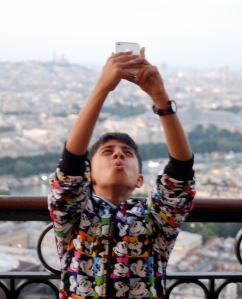Apple’s introduction of the front-facing camera ushered in the unofficial inauguration of the #selfie, and all of its counterparts: #selfienation, #selfieking, #selfiequeen, #selfiesonselfies, #selfiemonday, #selfietuesday….you get the picture. At the moment, #selfie alone registers nearly 53,000,000 posts on Instagram. The Oxford Dictionary recently added “selfie” to the dictionary. Our world is #selfied (more on the selfie phenomenon with this helpful infographic). Of course, our tendencies towards self-absorption are not new. Today the (sometimes accidental) narcissism is just a whole lot more public.
A simple but profound shift: from a camera that captures who and what is before me to a camera that captures…me.
Me and my cat. Me looking introspective. Me looking pouty. Me on a run. Me in my new fall outfit. Me. Me. Me.
Of course it’s rarely about the actual post, but the response that follows it. And it’s not just teens who so often appear consumed by the collection of friends, likes, views, retweets and repins. I’ve been there, and many days, I am there. We all like the nod of approval. Brian Solis writes of those consumed by a duality of a social life support system, where we are trying desperately to tie together who we are in our real life and our digital life.
My wondering is: How can we help my students hold their camera in a direction that gazes outward? And, how can we enable them to tell their story in the context of the Much Bigger Story they find themselves in?
Social media has both the power to draw people towards themselves, but it also has the power to pull people closer to one another. We can learn from others, we can share inspiration, we can start and share movements that make a difference all over the world. We can share creativity in ways previously unimagined. While you can find a plethora of selfie-inspired hashtags, you can find an equal number of hashtags for social good. Emphasizing this exciting and empowering aspect of social media is one way that we help ourselves, and our students, turn our gaze outward.
The #selfie isn’t going anywhere fast. There is little point in resenting its coming. As educators, we can model the power of social media for good- in a way that inspires and impacts the world around us. We can also help guide our students towards making good decisions about what and how they share their story (Edudemic provides a great starting point. Thanks, Kelsey!). As we transition from consuming to creating, let’s help our kids create for good, not just for themselves.
Do you see traces of the #selfienation in your classroom? In your kids at home? What are some of your favorite social movements for good?

Friend, have you read Susan Sontag’s essay “Regarding the Pain of Others”? It is, I think, a book and a chapter title, and I am referring to the chapter, but I have my students read it. It is an intense and incredible perspective on how the camera changed our experience of war and pain. I made a prezi on it to help my students follow the images! Just thought of it with your gaze comment.
I hadn’t heard of her essay. Thank you! It sounds like something I would definitely like to read…I shall check it out! Send the prezi link? 🙂 Thanks for stopping by, friend!
Is this the one?
She also has a great essay called On photography! written in 1977!! Brainpickings posted a retrospective of it just today:
http://www.brainpickings.org/index.php/2013/09/16/susan-sontag-on-photography-social-media/?utm_content=bufferd63fb&utm_source=buffer&utm_medium=twitter&utm_campaign=Buffer